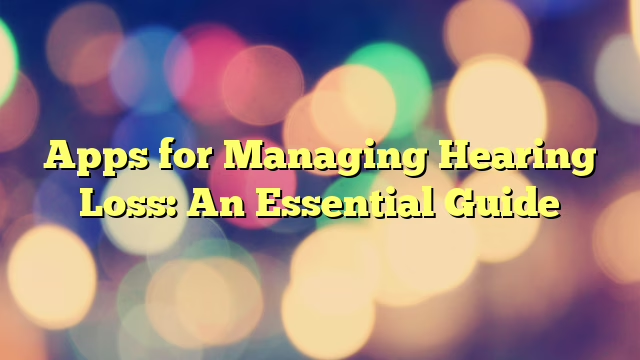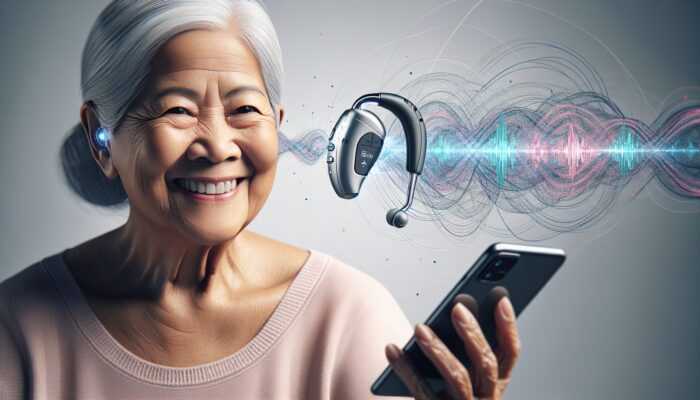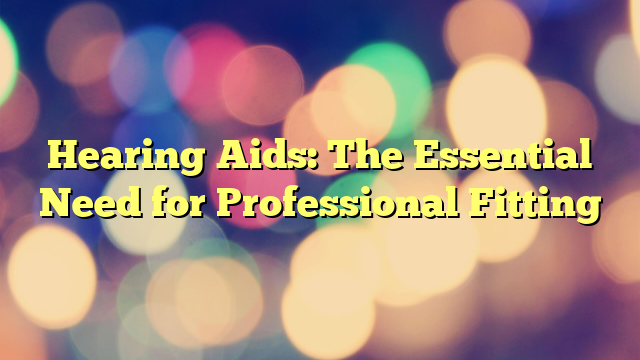Apps for Managing Hearing Loss: An Essential Guide

Last Updated on 24/10/2025 by Admin
Explore the Benefits of Hearing Loss Management Apps
What Are the Innovative Features of Hearing Loss Management Apps?
Hearing loss management apps represent cutting-edge digital solutions tailored for individuals experiencing hearing difficulties. These versatile applications boast features that enhance the auditory experience, such as sound amplification, advanced noise reduction, and customizable sound settings. In an era where clear communication is essential, these apps aim to remarkably enhance the quality of life for users facing hearing challenges. By utilizing state-of-the-art technology, these applications effectively bridge the communication gap often created by hearing loss in social settings, workplace interactions, and everyday activities.
As cases of hearing loss rise globally, these apps emerge as practical alternatives to traditional hearing aids, empowering users to take charge of their auditory health with ease and independence. Whether you find yourself in a vibrant café in Tokyo or at a family reunion in Buenos Aires, hearing loss management apps are becoming vital resources for enhancing communication and interaction across diverse cultural landscapes.
Discover the Essential Features of Hearing Loss Apps
One of the standout aspects of hearing loss management apps is their extensive array of essential features. These applications are typically designed with real-time sound adjustment functionalities, allowing users to customize their auditory experiences based on their surroundings. A crucial feature, background noise filtering, makes a significant impact in busy environments like open-plan offices in London or crowded markets in New Delhi. Personalized hearing profiles enable users to fine-tune their auditory settings according to their unique hearing loss patterns, ensuring a tailored experience.
Furthermore, many of these apps employ sophisticated algorithms that analyze the surrounding audio landscape. This processing capability is vital for helping users differentiate between important sounds, such as a friend’s voice in a bustling setting, and distracting noise. With these advanced functionalities, hearing loss apps go beyond being mere tools; they act as companions that assist users in navigating their auditory environments, fostering richer interactions in various social contexts.
Understanding Accessibility and User-Friendly Design
The design of hearing loss management apps emphasizes accessibility and user-friendliness. Developers are mindful of the diverse levels of technological proficiency among users; thus, these apps are designed to be intuitive and easy to navigate. Features such as large text options and voice commands greatly enhance the user experience, allowing individuals to manage complex settings effortlessly. For instance, in urban areas with fluctuating noise levels, the ability to utilize voice commands for sound adjustments proves to be particularly advantageous.
Moreover, these accessibility options cater to various age demographics, ensuring that all individuals, from young adults in Sydney to seniors in Cape Town, can benefit from these innovations. The user-friendly interface significantly reduces learning curves, enabling users to concentrate more on their social interactions rather than getting bogged down in managing their hearing assistance tools.
Uncover the Advantages of Hearing Loss Management Apps
The advantages of hearing loss management apps extend well beyond basic sound amplification. These applications greatly enhance communication by making conversations clearer and more enjoyable. By amplifying vital sounds while reducing distracting background noise, users can engage in social interactions with much more ease. This improvement in communication can boost users’ confidence and foster deeper connections in various scenarios, whether they are attending a family dinner or a professional meeting in New York City.
Additionally, the customizable features of these apps contribute to an enhanced quality of life. Users can participate more fully in favored activities, whether it involves enjoying music, attending concerts, or taking part in community events. Financial considerations also play a significant role; hearing loss management apps present a cost-effective alternative to conventional hearing aids, making these essential tools accessible to a wider audience. This affordability empowers users worldwide to address their hearing loss without experiencing financial hardship.
How to Choose the Right Hearing Loss App for Your Needs
Selecting the ideal hearing loss app is a crucial decision that demands thorough evaluation. Users should consider factors such as compatibility with their existing devices since many apps perform optimally when paired with specific smartphones or tablets. Reading user reviews can provide insights into the app’s effectiveness and ease of use, guiding prospective users in their choices. It is also essential to examine specific features that cater to individual hearing needs, such as adjustable frequency responses or noise-cancellation options.
To simplify the selection process, potential users can adopt actionable steps. Begin by checking compatibility with your device. Seek out apps that offer free trials or demo versions for testing before making a purchase. Review user feedback across various platforms to gauge real-world effectiveness, and prioritize applications known for their user-friendly interfaces. Lastly, reflect on the specific features that would best support your lifestyle, ensuring the app aligns with your unique auditory requirements.
How Do Hearing Loss Apps Operate Effectively?
Understanding Sound Processing and Amplification Techniques
Hearing loss apps utilize advanced technology to process and amplify sound efficiently. These applications employ sophisticated algorithms designed to analyze incoming audio signals, amplifying them as needed while filtering out undesirable noise. This capability is essential for individuals with hearing loss, as it allows them to enjoy a clearer auditory experience. For instance, when attending an outdoor festival in Berlin, users can enhance the sounds of live music while diminishing the overwhelming chatter from the crowd.
The sound processing mechanisms within these apps specifically cater to the needs of those with hearing impairments. They can adjust sound frequencies according to individual hearing loss patterns, guaranteeing that users gain the most from their listening experiences. Whether someone is trying to follow a conversation in a lively café in Paris or concentrating on a lecture at a university in Toronto, these apps provide tailored auditory environments that enhance engagement and understanding.
How Customization Meets Individual Hearing Needs
Customization stands out as a hallmark feature of hearing loss management apps, allowing users to adapt the technology to meet their specific hearing requirements. Users can modify settings including frequency response, volume levels, and noise reduction, establishing a personalized hearing profile that suits their individual hearing loss patterns. This degree of customization is crucial for ensuring that users maintain control over their auditory experiences, particularly in varying environments. For example, a user might require distinct settings for a tranquil library in Melbourne versus a bustling public transport system in Hong Kong.
This personalization empowers users to fine-tune their auditory settings based on their unique preferences and requirements. The capability to adjust settings in real-time allows users to respond dynamically to their surroundings, thereby enhancing communication and social interactions. Over time, users may develop preferences for certain settings in specific situations, leading to a more confident and enjoyable auditory experience.
Seamless Integration with Other Devices
Hearing loss management apps frequently offer seamless integration with other devices, enhancing their versatility and user-friendliness. By connecting with hearing aids, smartphones, and additional audio devices, these apps facilitate streamlined audio streaming and provide users with control over their auditory environments. For instance, a user can link their app to their smartphone during a video call, ensuring optimal sound quality while reducing background distractions.
This integration enables users to harness the power of technology, allowing them to manage their hearing loss across various contexts. In professional settings, for example, seamless connectivity can promote improved communication during meetings. Users can opt to stream audio directly from their devices or adjust sound settings according to their preferences, enhancing their engagement and participation in discussions. Additionally, as technology evolves, the compatibility of hearing loss apps with other health devices may broaden, providing users with even more comprehensive management options.
Expert Insights on the Impact of Apps on Hearing Loss Management
Real-World Examples of Effective App Usage
Real-world scenarios offer valuable insights into how hearing loss apps can be effectively utilized in everyday life. For example, a user may discover that the app significantly enhances their ability to engage in conversations at a friend’s wedding, where background music and chatter could otherwise obscure important voices. Similarly, another user might leverage the app during work meetings to better follow discussions, especially when colleagues speak in a conference room with challenging acoustics.
- A user enjoys a concert by adjusting the app settings to amplify musical instruments while minimizing crowd noise.
- A teacher utilizes the app during class to ensure that students with hearing impairments can hear lectures clearly.
- A family gathering becomes more enjoyable as a user can engage in conversations without repeatedly asking for clarifications.
- A person uses the app to navigate through the bustling sounds of a city, making it easier to recognize essential environmental cues.
These scenarios highlight the practical benefits of hearing loss apps, demonstrating their adaptability in various settings. By incorporating personal anecdotes and real-life applications, it becomes clearer how transformative these technologies can be for daily communication and social interactions.
Actionable Steps for Selecting the Right Hearing Loss App
When it comes to identifying the right hearing loss app, prospective users can follow several actionable steps. First, evaluate the compatibility of the app with your existing devices, as this is essential for ensuring a seamless experience. Many apps have specific requirements, making device compatibility a vital consideration. Next, assess the user interface; an intuitive layout can greatly enhance usability, especially for those who may not be technologically inclined.
User reviews and testimonials serve as invaluable resources in guiding your decision-making process. Look for feedback from other users with similar hearing loss profiles to understand how effective the app has been for them. Additionally, prioritize apps that offer free trials or demo versions. Testing the app prior to committing to a purchase allows users to evaluate its functionality and determine whether it aligns with their individual needs. Lastly, consider which specific features are critical for your lifestyle. For instance, if you frequently attend social events, seek apps with advanced noise filtering and amplification capabilities.
Expert Analysis on the Effectiveness of Hearing Loss Apps
Assessing the effectiveness of hearing loss apps involves examining user feedback, clinical studies, and technological advancements. Many users report significant enhancements in their ability to communicate and engage socially after incorporating these apps into their daily routines. Expert reviews often highlight sound quality, ease of use, and adaptability to different environments as pivotal factors influencing app effectiveness. For example, studies indicate that users who actively customize their app settings experience higher satisfaction and improved communication outcomes.
Moreover, technological advancements continue to enhance the performance of these apps. AI-driven features that adapt sound processing in real-time based on environmental noise levels are becoming increasingly prevalent. As technology progresses, the divide between traditional hearing aids and hearing loss apps narrows, enabling users to enjoy improved auditory experiences without the need for expensive devices. This expert analysis provides valuable insights into the potential impact of hearing loss apps on overall hearing health, empowering users to make informed choices.
How Apps Contribute to Hearing Rehabilitation
Hearing loss management apps are playing an increasingly integral role in hearing rehabilitation. These applications can provide a variety of exercises and training programs designed to enhance auditory skills. For individuals adjusting to new hearing aids or experiencing hearing loss for the first time, these resources offer essential support. Through structured training modules, users can practice focusing on specific sounds, distinguishing between different frequencies, and recognizing speech amidst noisy environments.
The integration of rehabilitation exercises within hearing loss apps is especially beneficial as it empowers users to take ownership of their auditory health. They can practice in the comfort of their homes, at their own pace, and monitor their progress over time. This personalized approach fosters a sense of achievement and reinforces positive behavioral changes in auditory processing skills. As users complete exercises and observe improvements, their confidence in social situations often increases, leading to more meaningful interactions and an enhanced overall quality of life.
Future Trends in Hearing Loss App Development
The future of hearing loss app development is on the brink of exciting advancements. One notable trend is the integration of AI technology, which promises to deliver personalized experiences that adapt to users’ distinct hearing environments. For instance, future apps may employ machine learning algorithms to analyze a user’s listening habits, automatically adjusting settings to optimize sound quality based on contextual factors.
Moreover, hearing loss apps are likely to expand their connectivity features, integrating with other health monitoring devices. This holistic approach could empower users to manage their overall well-being alongside their auditory health, creating a more comprehensive health management system. Increased user customization is also anticipated, enabling individuals to further fine-tune their hearing experiences. This could involve more granular control over sound settings, allowing users to tailor their auditory experiences to suit specific activities or environments. Additionally, enhancements in accessibility features, such as real-time captioning and sign language integration, will likely emerge, further improving communication for users with varying degrees of hearing loss.
Understanding the Limitations of Hearing Loss Apps
What Are the Technical Limitations of Hearing Loss Apps?
Despite their numerous advantages, hearing loss apps do present certain technical limitations. While they offer essential sound processing features, they may not entirely replicate the advanced capabilities found in high-end hearing aids. Many premium hearing aids incorporate sophisticated technology that finely tunes sound processing, which apps may struggle to match. Furthermore, the effectiveness of these apps can be influenced by the quality of the device they are installed on; older smartphones may not support new app functionalities, leading to less-than-optimal performance.
Additionally, the varying capabilities of different smartphone models can result in inconsistent user experiences. Users with higher-end devices may enjoy smoother operation and superior sound quality compared to those using older or lower-end models. This disparity underscores the importance of selecting compatible devices when investing in hearing loss management apps.
How User Dependence on Devices Affects Hearing Loss Management
Reliance on devices poses challenges for users of hearing loss apps. Many individuals may find themselves dependent on their smartphones or tablets, creating inconvenience in certain situations. For example, if a user forgets to charge their device or misplaces it, accessing their hearing assistance becomes problematic. This reliance can restrict users’ flexibility, making them more vulnerable in environments where they cannot easily access their devices.
Moreover, continuous dependence on these technologies can lead to frustration, especially if users encounter technical issues or app malfunctions. This reliance emphasizes the necessity for a backup plan, such as ensuring that traditional communication methods remain accessible. It reinforces the idea that while technology significantly enhances hearing management, it should not be the only solution.
Why Regular Updates Are Essential for Hearing Loss Apps
Regular updates are crucial for maintaining the effectiveness of hearing loss apps. These updates address functionality enhancements, fix bugs, and adapt to new technologies, ensuring that users access the most optimal experience. Failing to keep the app updated may result in decreased performance over time, ultimately hindering the user experience. This necessity for updates can also deter some users, particularly those who may not be comfortable with technology.
Moreover, consistent updates are vital for keeping pace with advancements in sound processing technology. As hearing loss management continues to evolve, app functionality must accordingly adapt. This ongoing development is essential to ensure that users can take advantage of the latest innovations in hearing assistance, equipping them with the necessary tools to navigate their auditory environments effectively.
What Are the Limited Customization Options Available in Hearing Loss Apps?
While customization is one of the appealing aspects of hearing loss apps, they often have limited options compared to professional hearing aids. These restrictions can impact users’ overall satisfaction and effectiveness in managing their hearing loss. For example, hearing aids typically allow for more precise adjustments tailored to the unique hearing profiles of individuals. Users may find that the hearing loss app lacks the granularity necessary to fully accommodate their specific needs.
This lack of tailored adjustments can affect the degree to which users feel supported in their hearing journey. While apps provide essential functionalities, they may not deliver the comprehensive solutions that professional devices can offer. Users should carefully assess their individual hearing requirements and consider whether the customization options available in apps meet their needs satisfactorily.
Anticipated Future Developments in Hearing Loss Apps
Anticipating Advancements in Sound Technology
The future of hearing loss management apps is set to embrace exciting <a href="https://www.earwaxremoval.net/hearing-aids-are-getting-smarter-with-enhanced-technology/">advancements in sound technology</a>. Emerging innovations, such as AI-driven noise cancellation and real-time sound optimization, are expected to significantly enhance user experiences. These technologies may enable apps to automatically adapt to a user’s surroundings, providing tailored sound adjustments that optimize listening quality in various environments.
Additionally, the integration of machine learning could facilitate continuous improvement in sound processing capabilities, allowing apps to learn from user interactions and preferences. This evolution ensures that as user needs change, the app can adjust accordingly, ultimately enhancing overall satisfaction and effectiveness. As these advancements unfold, users can look forward to increasingly sophisticated tools that empower them to proactively manage their hearing loss.
How Integration with Health Monitoring Systems Will Evolve
Future developments are likely to see greater integration of hearing loss apps with health monitoring systems. This integration can provide users with comprehensive health data, allowing them to manage their overall well-being alongside their auditory health. For instance, tracking hearing changes over time could grant users valuable insights into their hearing health, enabling informed decisions regarding their auditory management.
This holistic approach to health management reflects a growing trend toward integrating technology into everyday life, underscoring the importance of maintaining a comprehensive understanding of one’s health. By combining hearing loss management with broader health monitoring, users can benefit from a more unified approach to wellness that encourages proactive engagement with their health.
Increased User Customization in Future App Developments
Looking ahead, increased user customization is expected to become a focal point in the development of hearing loss management apps. Future iterations are anticipated to provide even more personalized options and features, enabling users to fine-tune their hearing experiences to a greater extent. This could include customizable profiles for various situations, allowing users to switch between settings based on their environment effortlessly.
Moreover, as users become more adept at understanding their hearing preferences, the ability to tailor their auditory experiences can lead to enhanced satisfaction and improved outcomes. By prioritizing user customization, developers can create applications that not only meet the general needs of individuals with hearing loss but also cater to the unique preferences of each user, ensuring optimal performance tailored to individual lifestyles.
What Enhanced Accessibility Features Can We Expect?
Future hearing loss apps are likely to incorporate enhanced accessibility features, addressing the diverse needs of users. Anticipated innovations include real-time captioning and sign language integration, which will improve communication for individuals with varying degrees of hearing loss. These features can promote inclusivity and ensure that users engage more effectively in a range of environments, from classrooms to social gatherings.
Moreover, by focusing on accessibility, developers can create applications that benefit not only users with hearing loss but also broader audiences, fostering an inclusive communication culture. This shift towards enhancing accessibility will further solidify the role of hearing loss management apps as essential tools that bridge communication gaps and empower users to lead fulfilling lives.
Frequently Asked Questions About Hearing Loss Management Apps
What Are Hearing Loss Management Apps?
Hearing loss management apps are digital tools specifically designed to assist individuals with hearing impairments by offering features such as sound amplification and noise reduction, ultimately enhancing the overall auditory experience.
How Do These Apps Work?
These applications utilize algorithms to process sound, amplifying necessary audio while filtering out unwanted noise, thereby allowing users to customize their listening environment based on their individual needs.
Can Hearing Loss Apps Be Used with Hearing Aids?
Yes, many hearing loss apps can seamlessly integrate with hearing aids and other audio devices, enabling users to enjoy streamlined audio streaming and greater control over their auditory experiences.
What Are the Benefits of Using Hearing Loss Management Apps?
The benefits encompass improved communication, enhanced quality of life, and cost-effectiveness, positioning them as practical alternatives to traditional hearing aids.
Are There Limitations to Using These Apps?
Limitations can include technical restrictions, dependence on devices, the necessity for regular updates, and limited customization options compared to professional hearing aids.
How Can Users Select the Right App for Their Needs?
Users should consider factors such as device compatibility, user reviews, interface design, and specific features required to ensure the app effectively meets individual hearing needs.
What Role Do Apps Play in Hearing Rehabilitation?
Hearing loss apps facilitate rehabilitation by offering exercises and training programs that enhance auditory skills and assist users in adapting to hearing aids.
What Trends Are Emerging in Hearing Loss App Development?
Emerging trends include the integration of AI for personalized experiences, enhanced connectivity with health devices, and improved accessibility features for diverse users.
How Do These Apps Affect Quality of Life?
By improving communication and providing better control over sound environments, hearing loss apps significantly enhance users’ quality of life and social interactions.
Are These Apps Suitable for All Age Groups?
Yes, hearing loss management apps are designed with user-friendliness in mind, making them accessible for individuals across various age groups and levels of technological proficiency.
Explore our world on X!
The post Apps for Managing Hearing Loss: An Essential Guide appeared first on The Microsuction Ear Wax Removal Network.










